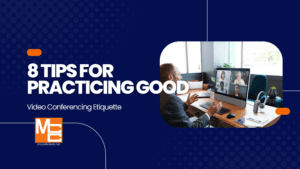
Video Conferencing Tips
If you work remotely and communicate with colleagues, clients, and other contacts via video conferencing, you know that it can be tricky to get used to. If done wrong, you look unprofessional, sound awkward, and feel awkward. But if done right? Well, that’s a whole different story! Here are our best tips for making the most out of your meetings:
1. Follow the same rules as an in-person meeting.
To ensure that everyone is on the same page, follow the same rules as an in-person meeting. If you are a manager, you should be leading the meeting and setting the agenda. If you are a team member, then it’s your job to listen to what your leader says and follow their lead during the call. And if you’re not involved in running this particular meeting but have been invited by someone else—whether it’s a CEO or an intern—you’ll likely want to pay close attention while they set up their webcam feed so they can provide instructions for how best to participate from wherever they’re calling from (see Tip #4).
2. Test the meeting software ahead of time.
Make sure to test out the meeting software ahead of time to ensure the software works on your specific computer system, you are familiar with the operation of the software, and you have all the camera and microphone equipment needed for the meeting. Testing prior to the meeting ensures the other participants do not have to deal with delays due to software glitches.
3. Test the video before jumping into a meeting.
Test your video and audio before the meeting starts. This gives you time to get your camera and mic settings correct and avoids delays and the infamous “Can you hear me now” question. Most meeting software gives you the option to test your audio and camera right before you join the meeting.
4. Mute your microphone when not speaking.
When you’re not speaking, make sure to mute your microphone. This tip is very important and should be followed so much it becomes habit. Microphones are designed to pick up all sounds and amplify them. This means every chair squeak, paper rustle, and coffee slurp comes through in the meeting louder (and more annoying) than it would in a regular in-person meeting. By muting your mic when you are not speaking, you save the other participants from having to hear all that unnecessary noise.
Webex, by Cisco, has built-in noise removal that eliminates all the background noise and focus on your voice only. This helps to get rid of those annoying noises for those times when you can’t mute your mic.
5. Look at the camera.
It might sound obvious, but it’s important to look at the camera and not the screen. This will ensure that you’re using your body language effectively, as well as making sure you don’t look distracted or bored.
When you are speaking to someone on video conferencing, make sure that you are looking into their eye—not just staring at them in general. Remember: use your face to show emotion! Or use the live reactions with Webex, which allows you to use hand gestures such as thumbs up or clapping to display emoji reactions on the screen in real time.
6. Dress appropriately.
The best way to put your best face forward is to dress professionally. You should dress as you would if you were meeting in person. If a shirt and tie and pajama bottoms would be inappropriate for an in-person meeting, they are inappropriate for a video call. Show the other participants some respect and dress appropriately.
Another consideration is for meetings that will be recorded. This could be a training session, a webinar, or any number of other meeting types. Cameras capture everything and amplify even the smallest imperfections: frizzy hair, wrinkled clothing, etc., so make sure that whatever outfit you choose is neat and tidy (and if there’s any grooming needed), then take care of it!
7. Be focused.
Stay focused. It can be easy to get distracted by other things, like your computer screen or phone. It’s important that you stay focused on the conversation and the person speaking to you so that you fully understand what they are saying and can respond appropriately.
Be present. While it may seem silly to tell someone “be present”, this is easier said than done when we’re used to multi-tasking while working. You want your listener/speaker’s attention focused on YOU, not on their own distractions or surroundings, so do the same for them.
8. Maintain the appropriate volume and distance
We have all been on a video conference with one of those people. You know the ones I mean. The guy that leans in so close to the screen you can see up his nose? Or the woman who speaks so softly you can’t hear her at all. Those are classic “what not to do” cases. During a video conference, you should sit up straight and maintain an appropriate distance from your camera. Adjust the camera so it is looking at your face, not your neck or just your forehead, and then stay there.
The same applies to your microphone. Test your microphone before the meeting begins and make sure your voice can be heard clearly. Adjust the mic volume as needed so that your voice is not too soft or too loud, but just right. Then maintain the same volume throughout the meeting so that the other participants do not have any problem understanding you.
Video conferencing is an effective way to communicate with clients, co-workers and others while working remotely. This can save you time and money because you don’t have to travel for meetings or conferences, which means no airplane tickets or hotels! While there are some who prefer in-person meetings, many more people prefer video conferencing over phone calls or email… so why not give it a try?
Learn more about our video conferencing solutions or speak to an expert today!



